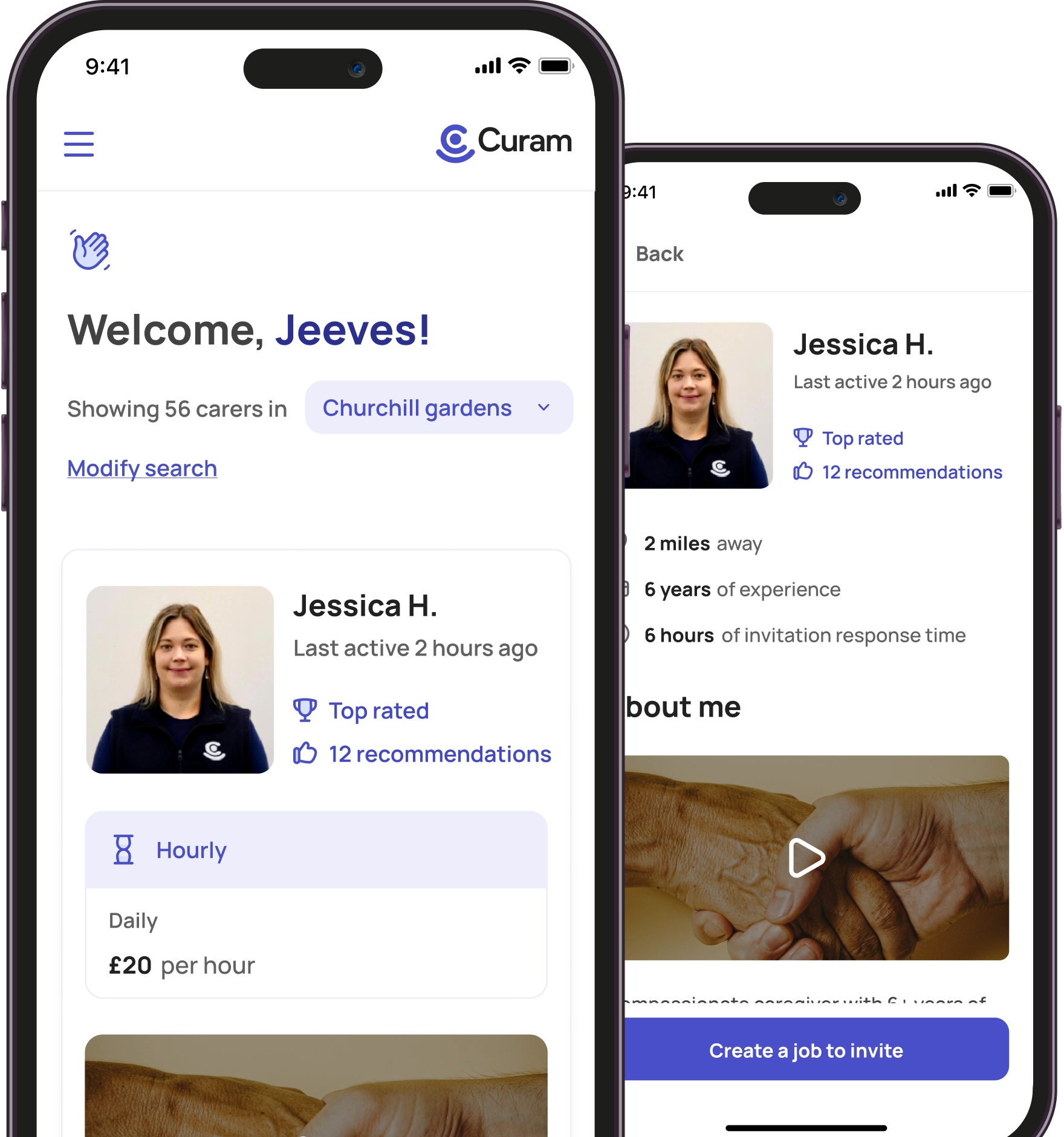The Benefits of Curam Live-in Care
Matching you with Care Professionals
Loading...
Bone Density
Bone density conditions, such as osteoporosis, can vary from person to person, and even from day today. While some individuals may experience constant pain, others may have periods of flare-ups. Effective management strategies, including medication, physical therapy, and lifestyle modifications, can both help alleviate the pain and improve the quality of life for individuals. For those dealing with bone density conditions, a Care Professional provides the support they need to live comfortably in the safe and familiar surroundings of their own home.
Recommended Bone density Care Professionals

5 years exp
2650+hrs worked

7 years exp
145hrs worked

20+ years exp
1119hrs worked

5 years exp
605hrs worked

2 years exp
362+hrs worked

5 years exp
522+hrs worked

4 years exp
8784+hrs worked
Understanding The Bone Density Test
A bone density test, also known as a DEXA scan (dual-energy X-ray absorptiometry), is a non-invasive procedure used to measure the strength and density of your bones. It's commonly used to diagnose osteoporosis and assess your risk of bone fractures.
During a bone density test, low-dose X-rays are emitted and directed through your bones to measure the amount of calcium and other minerals present. The results are typically given as a T-score and a Z-score, which indicate your bone density compared to that of a healthy young adult and someone of your age, sex, and ethnicity, respectively.
Why Should You Have a Bone Density Test?
Bone density tests are crucial for assessing bone health and detecting conditions like osteoporosis early on. Your doctor may recommend a DEXA scan if you're at risk of osteoporosis due to factors such as:
- Aging: As we age, our bones naturally become thinner and weaker.
- Gender: Women are more prone to osteoporosis, especially after menopause.
- Family history: If your parents or siblings have osteoporosis, you may be at a higher risk of developing osteoporosis.
- Lifestyle factors: Smoking, excessive alcohol consumption, a sedentary lifestyle, and a diet low in calcium and vitamin D can weaken bones.
- Certain medical conditions: Conditions like rheumatoid arthritis, hyperthyroidism, and gastrointestinal disorders can also affect bone density.
- Medications: Long-term use of certain medications like corticosteroids can also weaken bones.
Why Should You Have a Bone Density Test?
While Bone density tests are often associated with older adults, there are other groups of people who should consider getting tested earlier, these include:
- Women over the age of 65 and men over the age of 70, regardless of risk factors.
- Postmenopausal women under 65.
- Men aged 50-69 with risk factors.
- Individuals with a history of fractures due to minimal trauma.
- Those taking medications known to cause bone density loss.
- Anyone with medical conditions or lifestyle factors that increase the risk of osteoporosis.
How to Prepare for a Bone Density Test?
Preparing for a bone density test is relatively simple. You may be asked to avoid taking calcium supplements for at least 24 hours before the test, as they can affect the results. Wear loose, comfortable clothing and avoid clothing with metal zippers or buttons, as they may interfere with the X-ray images.
What Happens During the Bone Density Test?
During a bone density test, you'll lie on a flat, open, padded X-ray table while a scanning arm passes over your body, emitting low-dose X-rays. The test usually focuses on your hip, spine, or forearm, as these areas are most susceptible to fractures. The procedure is painless and typically takes about 10-30 minutes, depending on the areas being scanned.
After the test, you can resume your normal activities with no downtime. Your doctor will discuss the results with you, including any necessary follow-up steps.
What Are Possible Risks of a Bone Density Test?
Bone density tests are generally safe and non-invasive, with minimal radiation exposure. However, there are some risks associated with the procedure, such as:
- Radiation exposure: While the amount of radiation used in a bone density test is minimal, it's still important to inform your doctor if you're pregnant or may be pregnant.
- False-positive results: In some cases, bone density tests may overestimate the risk of fractures, leading to unnecessary worry or treatment.
- False-negative results: Conversely, the test may underestimate the risk of fractures in certain individuals, delaying necessary interventions.
It's essential to discuss any concerns with your doctor before undergoing a bone density test.
Results of a Bone Density Test. What can I expect?
The results of a bone density test are typically given as a T-score and a Z-score.
A T-score is calculated by comparing your bone density to that of a healthy young adult of the same sex. A T-score between +1 and -1 is considered normal, while a T-score between -1 and -2.5 indicates osteopenia (low bone density) and a T-score of -2.5 or lower suggests osteoporosis.
A Z-score is calculated by comparing your bone density to that of someone your age, sex, and ethnicity. A Z-score below -2.0 may indicate that your bone density is lower than expected for your age group.
Understanding your bone density test results can help guide treatment and lifestyle changes to improve bone health and reduce the risk of fractures.
Bone density tests are valuable tools for assessing bone health and detecting conditions like osteoporosis early on. By understanding the purpose of these tests, who should consider getting tested, and what to expect during the procedure, individuals can take proactive steps to maintain strong and healthy bones throughout their lives. If you have any concerns about your bone health or risk factors for osteoporosis, be sure to discuss them with your healthcare provider.
FAQ's
The age at which you should get a DEXA scan depends on several factors, including your risk factors for osteoporosis and whether you've historically experienced any fractures or bone-related issues. However, certain guidelines can help determine when to consider getting tested. These include:
- Postmenopausal Women: For women who have gone through menopause, bone density tends to decrease more rapidly due to hormonal changes. Therefore, it's generally recommended that women undergo a bone density test around the age of 65, regardless of other risk factors.
- Men over 70: While osteoporosis is more commonly associated with women, men can also develop the condition, especially as they age. Men aged 70 and older should consider getting a bone density test, particularly if they have risk factors such as a family history of osteoporosis or a history of fractures.
- Younger Individuals with Risk Factors: In some cases, younger individuals may need a bone density test if they have certain risk factors for osteoporosis, such as long-term steroid use, a family history of osteoporosis, or medical conditions that affect bone health. In these cases, the decision to undergo testing should be made in consultation with a healthcare provider.
- Fracture History: If you've experienced a fracture due to minimal trauma or have a history of fractures, regardless of age, your doctor may recommend a bone density test to assess your bone health and risk of future fractures.
- Specific Medical Conditions or Medications: Certain medical conditions and medications can increase the risk of osteoporosis and bone fractures at any age. If you have conditions such as rheumatoid arthritis, hyperthyroidism, or gastrointestinal disorders, or if you're taking medications known to affect bone density, your doctor may recommend earlier testing.
Ultimately, the decision to undergo a bone density test should be based on a combination of age, risk factors, and individual health history. It's essential to discuss your bone health with your healthcare provider, who can help determine the appropriate timing for testing and provide guidance on preventive measures and treatment options if necessary.
A "bad" bone density score typically refers to results that indicate low bone density or the presence of osteoporosis, a condition characterised by weakened and brittle bones. Scores that indicate low bone density or osteoporosis are usually reported as T-scores.
A T-score between +1 and –1, is considered normal bone density. This means your bone density is within the expected range for a healthy young adult of the same sex.
Osteopenia (Low Bone Density): A T-score between -1 and -2.5 indicates osteopenia, or low bone density. While not as severe as osteoporosis, osteopenia indicates that your bones are weaker than normal and may be at increased risk of fracture.
Osteoporosis: A T-score of -2.5 or lower indicates osteoporosis. This means your bone density is significantly below the average bone density of a healthy young adult, putting you at a higher risk of fractures, even with minor falls.
It's important to note that a bone density score is just one factor in assessing bone health and fracture risk. Other factors, such as age, sex, family history, lifestyle habits, and previous fractures, also play a role in determining overall bone health.
If you receive a bone density score indicating osteopenia or osteoporosis, your healthcare provider will work with you to develop a treatment plan aimed at improving bone density, reducing fracture risk, and promoting overall bone health. This may include lifestyle changes, dietary modifications, supplements, medications, and regular monitoring to track progress and adjust treatment as needed.
No, getting a bone density test is typically not painful. It's a non-invasive procedure that involves lying comfortably on a padded table while a scanning arm passes over your body, emitting low-dose X-rays. During the test, you won't feel any discomfort or pain. The procedure is quick and usually takes around 10-30 minutes, depending on the areas being scanned. You'll need to remain still during the scan to ensure accurate results, but aside from that, there's no special preparation or discomfort involved.
Some people may experience mild anxiety or claustrophobia while lying on the scanning table, especially if they're uncomfortable in enclosed spaces. However, the open design of most bone density machines helps alleviate this issue for many individuals.
Overall, while some may find the experience slightly uncomfortable due to the need to remain still or feelings of anxiety, getting a bone density test is generally well-tolerated and pain-free. If you have concerns about the procedure or experience any discomfort during the test, don't hesitate to communicate with the technologist performing the scan. They can offer reassurance and ensure your comfort throughout the test.
A bone density test can help identify various bone-related issues and assess overall bone health. Here are some problems that a bone density test can reveal:
- Osteoporosis: One of the primary purposes of a bone density test is to diagnose osteoporosis. Osteoporosis is a condition characterised by low bone density and an increased risk of fractures.
- Osteopenia: In addition to diagnosing osteoporosis, a bone density test can also detect osteopenia, a condition characterised by lower-than-normal bone density but not as severe as osteoporosis. Osteopenia indicates a higher risk of developing osteoporosis in the future.
- Fracture Risk: By assessing bone density, a bone density test can help estimate an individual's risk of fractures, particularly in areas such as the hip, spine, and forearm. Low bone density increases the likelihood of fractures, even with falls or minor trauma.
- Monitoring Treatment Effectiveness: For individuals undergoing treatment for osteoporosis or other bone-related conditions, regular bone density tests can help monitor the effectiveness of treatment and track changes in bone density over time.
- Bone Health Assessment: Beyond diagnosing specific conditions, a bone density test provides valuable information about overall bone health. It can identify individuals at higher risk of fractures due to factors such as aging, hormonal changes, medication use, or lifestyle habits.
- Secondary Causes of Bone Density Loss: In some cases, a bone density test may reveal secondary causes of bone density loss, such as hormonal imbalances, nutritional deficiencies, or medical conditions like hyperparathyroidism or Cushing's syndrome. Identifying these underlying causes is essential for appropriate treatment and management.
Overall, a bone density test is a valuable tool for assessing bone health, diagnosing osteoporosis and osteopenia, estimating fracture risk, and monitoring treatment effectiveness. It provides crucial information that can guide healthcare providers in developing personalised strategies for maintaining and improving bone health.
Bone mineral density (BMD) is a measurement of the amount of mineral content, primarily calcium and phosphorus, present in bone tissue. It is an essential indicator of bone strength and density, reflecting the structural integrity of bones.
Calcium and phosphorus are crucial minerals that contribute to the formation and maintenance of healthy bones. Bone mineral density is highest during early adulthood when bones are still growing and developing. After reaching peak bone mass, typically in the late twenties to early thirties, bone density gradually decreases with age.
Adequate bone mineral density is essential for maintaining bone strength and reducing the risk of fractures, particularly in older adults. Low bone mineral density, known as osteopenia or osteoporosis depending on severity, can increase the risk of fractures and other bone-related complications.
Bone mineral density is typically measured using a technique called dual-energy X-ray absorptiometry (DEXA or DXA). Maintaining optimal bone mineral density is essential for overall bone health and reducing the risk of osteoporosis and fractures. Lifestyle factors such as regular weight-bearing exercise, adequate intake of calcium and vitamin D, and avoiding smoking and excessive alcohol consumption can help support healthy bone mineral density throughout life.

Check average rates in your postcode
With Curam you pay less but your Care Professional earns more
Clients on the Curam platform pay on average 22% less than the current suggested UK Home Care Association hourly rate of £28.53

Thousand of satisfied clients have used hourly in-home care with Curam
Full choice over who provides care
Get Care Professionals for your care needs
You can join for free, no tie-in contracts.

We are making sure you get the ideal Care Professional with each passing day
5 million+
Hours of high quality
care delivered
8335+
Experienced &
vetted Care Professionals
6351+
people hired
Care Professionals successfully
10 years
Average experience
of a Curam Care Professional
5
Average number
of applications
<2 hours
Average response
time from Care Professionals





